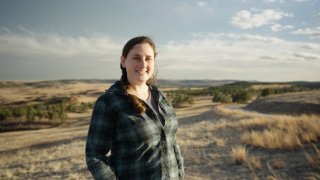
Myers works as a forester in national land management.
This story is part of CNBC Make It's Millennial Money series, which details how people around the world earn, spend and save their money.
Sarah Myers has always loved the outdoors.
Watch NBC 5 free wherever you are
Growing up in Vermont and New York, the 33-year-old spent summers camping, canoeing and hiking in the Adirondacks with her family. So when it came time to pick a career, "I knew I wanted to work in land management," she tells CNBC Make It.
Myers now works as a forester where she ensures the continual growth of forests, works on timber sales and helps manage fires during fire season.
Get top local stories in DFW delivered to you every morning with NBC DFW's News Headlines newsletter.
"I love the sense of history you get in the forests," she says. "I love the idea that these trees have been here for generations and they'll outlive me."
In 2024, Myers made $92,100 working in federal land management. She lives in Hot Springs, South Dakota, with her partner. Here's how she's built her nature-focused career and how she funds her life in the Midwest.
'Seasonal work is hard because you're not settled anywhere'
Money Report
Getting into forestry was no easy feat.
Myers has a bachelor's degree in natural resource management from Cornell University and a master's in geographic information science from Penn State. While she was still at Cornell, a mentor told her that to qualify for a federal position she should expect to do "about six to eight years-worth of seasonal positions," she says.
That was exactly the path she ended up taking.
Myers held five seasonal positions, each lasting four to six months, between 2013 and 2017. She worked throughout the Northeast and northern Great Plains, as well as a winter in Alaska, earning about $15 an hour, she says. Her duties included measuring tree characteristics like species, age and height.
"Seasonal work is hard because you're not settled anywhere," she says. "You're living out of suitcases and what you can move in your car."

In January 2018, she landed her first permanent position as a forester in Colorado and moved into her current position as a supervisory forester in September 2022.
Day-to-day, Myers works on project and budget planning for planting trees, helping young trees grow and improve their health, and commercial timber sales. During fire season, she's mapping out where wildfires, firefighters and supplies are.
She loves it. "It really feels like the perfect position just opened up and took a little bit from all my experience and all my background," she says.
'We're not nitpicking and we're not counting pennies'
Myers' annual income varies. In 2024, her base salary increased to $77,390 per year, plus $14,710 in overtime pay she picked up during fire season, bringing her total to $92,100. She lives with her partner of 10 years, who also works for the federal government and makes a similar salary, she says.
Here's what Myers' spending looked like in February.

- Food: $1,360 on groceries and dining out
- Housing and utilities: $1,200 for her half of the mortgage, property taxes, home insurance and utilities
- Discretionary: $1,167 for travel, entertainment, home improvement projects, home goods, pet food, clothing, work supplies and music
- Savings and investments: $1,052 into her pension and Thrift Savings Plan
- Insurance: $531 for health, dental, vision, life, car and pet
- Gas: $119
- Phone: $97
- Subscriptions and memberships: $11 for HBO Max
Myers and her boyfriend bought a three-bedroom, one-and-a-half bathroom home in 2022 for around $300,000. Myers paid the $65,000 down payment with a combination of her savings and an inheritance.
To cover monthly costs, both contribute to a joint savings account. Myers puts in $1,200 every month — slightly more than her partner because she prefers to leave a buffer in the account just in case utilities are higher than expected.
Otherwise, she generally covers the cost of her own groceries, phone bill, gas and savings. But they're not sticklers about only using or eating what they paid for. "We're not nitpicking and we're not counting pennies," she says.
One unusual component of her discretionary spending in February was a $440 Apple Music bill. She still uses her iTunes library and bought a lot of new music.
Myers has multiple savings accounts, including an emergency fund worth about $5,900 and a high-yield account with $15,880 in it, which will help her buy her next car. She also makes monthly contributions to her Thrift Savings Plan through her employer, and has about $79,380 in it as of February.
'The ultimate financial goal is to be able to retire earlier'
Big picture, Myers and her partner are comfortable. But factors like inflation have taken a toll.
"We can take care of our house, we can pay the mortgage," she says, "but saving for larger purchases or vacations, it's those luxuries that aren't happening."
And given the recent changes in the federal government, she's also not sure what they'll do should they lose their jobs. Even state-oriented and nonprofit land management positions depend on federal funding in some way, she says.
"We don't have much of a safety net," she says.
That has given Myers and her boyfriend a chance to think about what they'd want to do next or even in retirement. "The ultimate financial goal is to be able to retire earlier and then pursue a second career starting our own small business," she says.
"I, as a child, produced maple syrup for fun," Myers says. "And I've sort of always dreamed about moving back to the Northeast to a sugar bush on some land somewhere and producing maple syrup and maybe having a little farm."
What's your budget breakdown? Share your story with us for a chance to be featured in a future installment.
Want to earn some extra money on the side? Take CNBC's new online course How to Start a Side Hustle to learn tips to get started and strategies for success from top side hustle experts. Sign up now and use coupon code EARLYBIRD for an introductory discount of 30% off $97 (+taxes and fees) through April 1, 2025.






